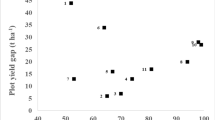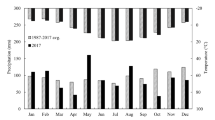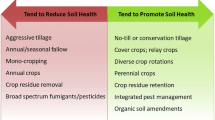Abstract
High-yielding potato crops in Canterbury have achieved 90 t ha−1or more. However, soil-borne diseases and poor soil structure are primary factors responsible for reducing this potential to an average of 55 t ha−1. The interaction between these factors was measured by growing the cultivars ‘Russet Burbank’ and ‘Innovator’ in 15 fields, grouped into four categories related to cropping history that influences soil health: soil-restorative (>7 years of grass) and non-restorative (>6 annual crops) with presence or absence of potato crops in the previous 10 years. Although predominantly grass histories with previous potato crops showed greater severity of soil-borne diseases than annual crop history without previous potatoes, this did not lead to yield losses. Improved soil quality increased yields by an average 10 t ha−1 regardless of disease pressure. Modelling suggested that early planting, maintaining crop canopies and managing water supply were also key factors for achieving high potato yields.
Resumen
Los cultivos de papa de alto rendimiento en Canterbury han alcanzado las 90 t ha−1 o mas. No obstante, las enfermedades del suelo y la estructura pobre del suelo son los factores primarios responsables de la reducción de este potencial a un promedio de 55 t ha−1. Se midió la interacción entre estos factores mediante el cultivo de las variedades “Russet Burbank” e “Innovator” en 15 campos, agrupados en cuatro categorías relacionadas a la historia del cultivo que influencia la salud del suelo: restauración del suelo (>7 años de pasto) y no restauración (>6 cultivos anuales) con la presencia o ausencia de cultivos de papa en los 10 años previos. Aunque las historias del pasto predominante con cultivo de papa previo mostraron mayor severidad de las enfermedades del suelo que la historia de cultivos anuales sin papa previa, esto no condujo a pérdidas de rendimiento. El mejoramiento de la calidad del suelo aumentó los rendimientos en un promedio de 10 t ha−1independientemente de la presión de enfermedades. El modelado sugirió que la siembra temprana, el mantenimiento del follaje y el manejo del suministro de agua, también fueron factores clave para lograr altos rendimientos de papa.



Similar content being viewed by others
References
Arcila Aristizabal, I.M., E.P. Gonzales, C.M. Zuluaga, and J.M. Cotes. 2013. Alternate hosts of Spongospora subterranea f.sp. subterranea in Colombia by bio-assay. Revista Facultad Nacional de agronomia Medellin 66: 6987–6998.
Beare MH, Tregurtha CS, Lawrence EJ 2003. Quantifying the effects of management history on soil quality and crop performance using the soil quality management system. Pp 167-174. In: Tools for Nutrient and Pollutant Management: applications to agriculture and the environmental quality. (Eds L.D. Currie and J.A. Hanly) Occasional Report No. 17. Fertilizer & Lime Research Centre, Massey University, Palmerston North.
Brierley J., S. Wale, J. Woodhall, A. Lees, J. Peters, D. Kiezebrink, L. Sparrow, K. Ophelkeller, 2013. Informing Management of Potato Diseases through epidemiology and diagnostics. Rhizoctonia solani Reviews. http://www.potato.org.uk/sites/default/files/publication_upload/R422%20Final%20Report.pdf. Accessed 1 March 2019.
Falloon, R. 2008. Control of powdery scab of potato: Towards integrated disease management. American Journal of Potato Research 85: 253–260. https://doi.org/10.1007/s12230-008-9022-6.
Falloon, R.E., A.R. Wallace, M. Braithwaite, R.A. Genet, H.M. Nott, J.D. Fletcher, and W.F. Braam. 1996. Assessment of seed tuber, in-furrow and foliar chemical treatments for control of powdery scab (Spongospora subterranea f. sp. subterranea) of potato. New Zealand Journal of Crop and Horticultural Science 24: 341–353.
Falloon, R.E., U. Merz, R.C. Butler, D. Curtin, R.A. Lister, and S.M. Thomas. 2016. Root infection of potato by Spongospora subterranea: Knowledge review and evidence for decreased plant productivity. Plant Pathology 65: 422–434.
GenStat 17th edition. VSN International (2017). GenStat for Windows 17th Edition. VSN International, Hemel Hempstead, UK. Web page: GenStat.co.uk.
Harrison, J.G., R.J. Searle, and N.A. Williams. 1997. Powdery scab disease of potato – A review. Plant Pathology 46: 1–25.
Hernandez-Ramirez, G., E.J. Lawrence-Smith, S.M. Sinton, F. Tabley, A. Schwen, M.H. Beare, and H.E. Brown. 2014. Root responses to alterations in macroporosity and penetrability in a silt loam soil. Soil Science Society of America Journal 78: 1392–1403.
Jamieson, P.D., P.J. Stone, R.F. Zyskowski, and S. Sinton. 2003. Implementation and testing of the potato calculator: A decision support system for nitrogen and irrigation management. In Decision support systems in potato production: Bringing models to practice, ed. A.J. Haverkort and D.K.L. Mackerron, 85–99. Wageningen: Academic Publishers.
Jamieson, P.D., R.F. Zyskowski, F.Y. Li, and M.A. Semenov. 2008. Water and nitrogen uptake and responses in models of wheat, potatoes and maize. In Quantifying and understanding plant nitrogen uptake for systems modelling, ed. L.L. Ma, L.R. Ahuja, and T.W. Bruulsema, 127–146. Abingdon: CRC Press.
Johansen, T.J., M.G. Thomsen, A. Løes, and H. Riley. 2015. Root development in potato and carrot crops – Influences of soil compaction. Acta Agriculturae Scandinavica Section B Soil and Plant Science 65: 182–192. https://doi.org/10.1080/09064710.2014.977942.
Kemper, W.D., and R.C. Rosenau. 1986. Aggregate stability and size distribution. In Methods of soil analysis, part 1. Physical and mineralogical methods, ed. A. Klute, 2nd ed., 425–442. Madison: Soil Science Society of America.
Michel A, H. Brown, S. Sinton, E. Meenken, S. Dellow, S Pethybridge, B. Searle, J. Reid 2013. Potato yield gap investigation 2012–13. Part B: Effect of nutrient supply on yield. Report for: Potatoes New Zealand, McCain growers group and Ravensdown Fertiliser co-operative limited. Alexandre Michel - Part B - Effect of Nutrient Supply on Yield, https://potatoesnz.co.nz/library/?mdocs-cat=mdocs-cat-52&mdocs-att=null#. Accessed 20 August 2019.
Monteith, J.L. 1977. Climate and the efficiency of crop production in Britain. Philosophical Transactions. Royal Society of London B281: 277–294.
Qu, X., and B.J. Christ. 2006. The host range of Spongospora subterranea f. sp. subterranea in the United States American Journal of Potato Research 83: 343.
Reid, J.B., B.P. Searle, and S. Sinton. 2011. Does my potato crop need fertiliser? A modelling approach. Agronomy New Zealand 41: 79–95.
Reid, J.B., B. Searle, S. Sinton, A. Michel, E. Meenken, H. Brown, A. Roberts, and M. Manning. 2016. Fertiliser practice and yield losses in process potato crops grown in Canterbury, New Zealand. New Zealand Journal of Crop and Horticultural Science 44: 1–17.
Sinton S, Falloon R, Brown H, Tregurtha C, Michel A, Dellow S, Reid J, Shah F, Pethybridge S, Searle, 2013. Potato yield gap investigation 2012–13. Part A: Factors limiting yield. Report for: Potatoes New Zealand, McCain Growers Group and Ravensdown Fertiliser Co-operative Limited. 0136 (8706) Potato Yield Gap Investigation 2012–13; Part A Factors Limiting Yield (1), https://potatoesnz.co.nz/library/?mdocs-cat=mdocs-cat-52&mdocs-att=null#. Accessed 20 August 2019.
Sinton S, Dellow S, Shah F, Richards K, Michel A, Linton J, 2018. P15–01: Increasing potato yield through understanding the impacts of crop rotations and soil compaction – Year 3. Increasing potato yield through understanding the impacts of crop rotations and soil compaction - Year 3–2018, Sinton S, 2018. https://potatoesnz.co.nz/library/?mdocs-cat=mdocs-cat-52&mdocs-att=null#. Accessed 20 August 2019.
Statistics New Zealand, 2016. Agricultural and Horticultural Land Use. http://archive.stats.govt Statistics New Zealand, 2016. Agricultural and Horticultural Land Use. http://archive.stats.govt.nz/browse_for_stats/environment/environmental-reporting-series/environmental-indicators/Home/Land/land-use.aspx.nz/browse_for_stats/environment/environmental-reporting-series/environmental-indicators/Home/Land/land-use.aspx. Accessed 20 August 2019.
Tsror, L. 2010. Review: Biology, epidemiology and management of Rhizoctonia solani on potato. Journal of Phytopathology 158: 649–658.
Webb, T.H., J.J. Claydon, and S.R. Harris. 2000. Quantifying variability of soil physical properties within soil series to address modern land-use issues on the Canterbury Plains, New Zealand. Australian Journal of Soil Research 38: 1115–1129.
Wright, P.J., R.E. Falloon, and D. Hedderley. 2017. A long-term vegetable crop rotation study to determine effects on soil microbial communities and soilborne diseases of potato and onion. New Zealand Journal of Crop and Horticultural Science 45: 29–54.
Acknowledgements
This research was carried out by The New Zealand Institute for Plant and Food Research Limited, on behalf of the Foundation for Arable Research, the Sustainable Farming Fund (Ministry for Primary Industries) and Potatoes New Zealand. The participating growers are gratefully acknowledged for providing land, assisting with planting, field experiment maintenance and harvest. The New Zealand potato industry provided seed potatoes, access to seed tuber treatment equipment, and facilities for transport of harvested potatoes.
Author information
Authors and Affiliations
Corresponding author
Ethics declarations
Disclaimer
The New Zealand Institute for Plant & Food Research Limited does not give any prediction, warranty or assurance in relation to the accuracy of or fitness for any particular use or application of, any information or scientific or other result contained in this paper. Neither Plant & Food Research nor any of its employees shall be liable for any cost (including legal costs), claim, liability, loss, damage, injury or the like, which may be suffered or incurred as a direct or indirect result of the reliance by any person on any information contained in this paper.
Rights and permissions
About this article
Cite this article
Sinton, S.M., Dellow, S.J., Jamieson, P.D. et al. Cropping History Affects Potato Yields in Canterbury, New Zealand. Am. J. Potato Res. 97, 202–213 (2020). https://doi.org/10.1007/s12230-020-09767-3
Published:
Issue Date:
DOI: https://doi.org/10.1007/s12230-020-09767-3




